|
 Nederlands /
Dutch Nederlands /
Dutch
Autumn

In the autumn there is
still enough to discover. Some plants remain flowering. For instance the knotweed
(Polygonum amplexicaule). Annual
Honesty or Silver
Dollar (Lunaria
annua) shows its seed pods with the appearance of silver coins.
I like to peel
the thin layers from the seed pods to get the “silver dollars”. My
terrace has been renewed and made larger. The hedge of English
yew
(Taxus
bacata)
at the left has been pruned two meters lower. Now I can see the houses again.
That’s a pity, but we get more
sunlight in the garden now.
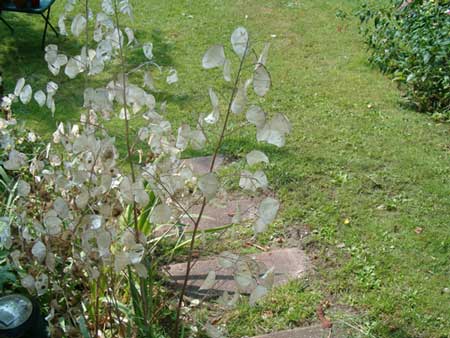 ..... .....
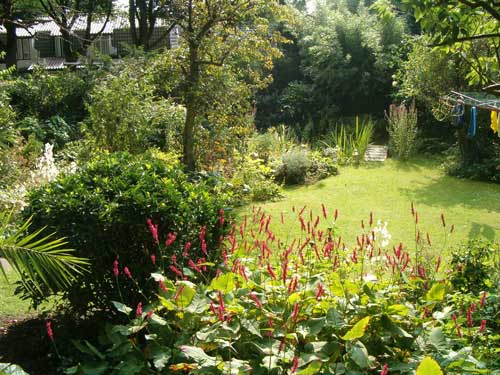 |
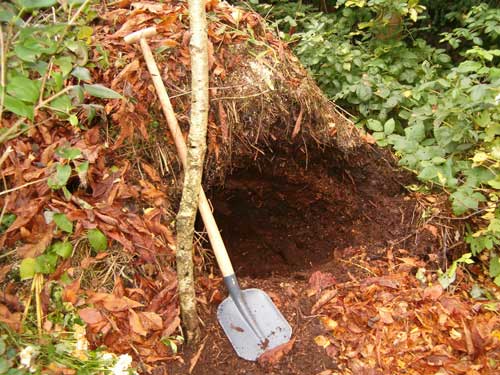 ..... .....
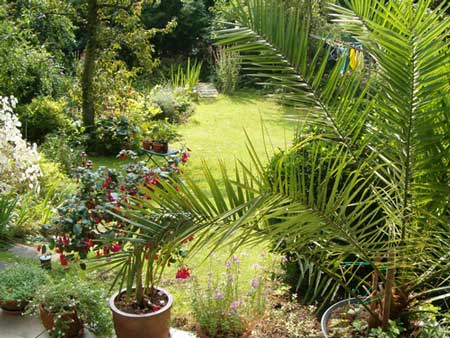 |
The compost heap must be
removed and spread throughout our garden. I make compost of all household
and garden waste. I mix the leaves with old compost. After a year I
have good compost again.
I posted these photos on the website years ago. I leave them as they are, because I still like to look at them. Most of the plants as well as the compost pile are still there. Only the palm has died. It was not hardy and grew too big to stand in the room. After that we bought a very small
hardy palm, Trachycarpus fortunei. First it stood in the flower pot of the previous palm. When
it got too big I put him in about the same spot in the garden. It grows faster and faster.
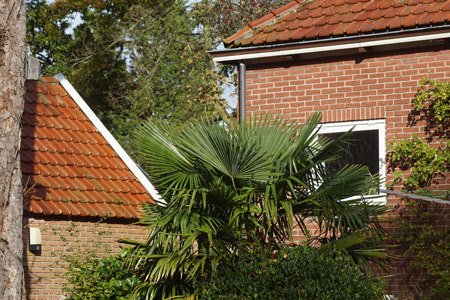 Chinese windmill palm, windmill palm, Chusan palm, (Trachycarpus fortunei). Photo
8-11-2021
Chinese windmill palm, windmill palm, Chusan palm, (Trachycarpus fortunei). Photo
8-11-2021
The mushrooms, which I see
a lot in the garden, are the earthstar
and the common earthball.
On both mushrooms you can see an insect.
Two autumn pictures. A feather between the leaves.
A yellow foxglove in autumn.
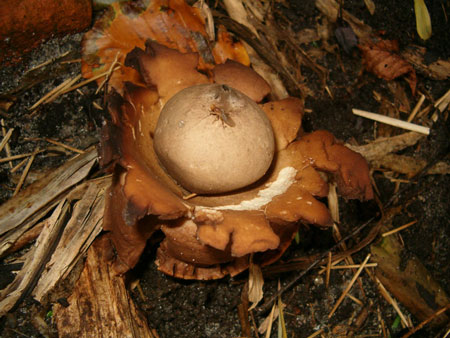 ..... .....
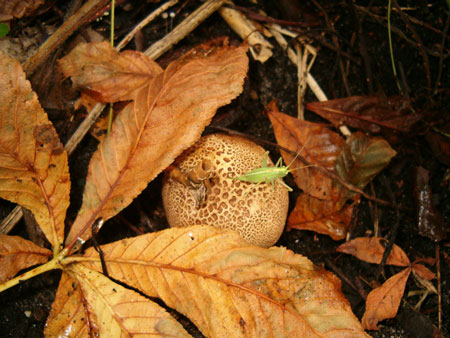 |
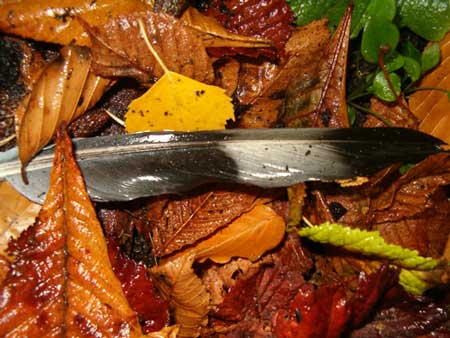 ..... .....
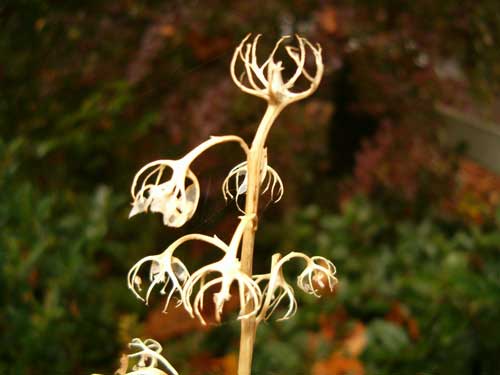 |
Actually I don't know much about mushrooms. But I have placed a few photos on this page.
I want to thank everyone, who has helped me (waarneming.nl) to identify.



 Champignon
spec. Family Agaricaceae.
Champignon
spec. Family Agaricaceae.
These
mushrooms are edible. But I don't try.
Scaly Wood Mushroom, Blushing Wood Mushroom (Agaricus silvaticus) is possible if you look at these photos. But then the
colour changes to blood red or pink when you
cut Agaricus silvaticus. Unfortunately the colour of this mushroom did not change.
|
 Coprinus micaceus The similar species C. pallidissimus and C. truncorum
are also possible. But they are much rarer. Family Coprinaceae.
Coprinus micaceus The similar species C. pallidissimus and C. truncorum
are also possible. But they are much rarer. Family Coprinaceae.
These fungi arise in small clumps. As shown in this picture. When they are
young, the mushrooms are covered in tiny white granules.
On dead tree stumps, as well as (like here) on rich soil. May to November. |

 Cerocorticium molare Family Cyphellaceae.
Cerocorticium molare Family Cyphellaceae.
The fruiting body has a surface
of a crust covered with about 4 mm long blunt spines with a whitish margin (about 4 cm). A close relative of the
Cerocorticium
confluens. When you rub it, you smell a chemical odor. Found on
branches
blown off an oak |


 Collared earthstar, saucered earthstar, triple earthastar
(Geastrum triplex) Family earthstar fungi (Geastraceae).
Collared earthstar, saucered earthstar, triple earthastar
(Geastrum triplex) Family earthstar fungi (Geastraceae).
In Europe there are 20 species. The collar is especially visible in the right picture. In other pictures you can see
that the outer wall splits into 4 to 8 pointed rays. They crack as they
bend back.
Especially in woodlands and dunes. Asia,
Australasia, Europe, and both North and South Americ |

 Helmmycena (Mycena galericulata) Family Mycenaceae.
Helmmycena (Mycena galericulata) Family Mycenaceae.
Characteristic of this species: White gills (with a slightly reddish lights).
The cap is bell-shaped with a hump in the middle. It smells like flour.
In clusters on tree trunks. Here they are on deciduous pieces of wood. |

 Hapalopilus rutilans Family Polyporaceae.
Hapalopilus rutilans Family Polyporaceae.
The cap has a curved edge. On the cap you see pores 4-10 mm ldeep. The fragrance is sweet.
The colour changes to purple when you drop lye (KOH) or ammonia on it. Found on
branches
blown off an oak. |

 Psathyrella spec. Family Psathyrellaceae.
Psathyrella spec. Family Psathyrellaceae.
I can't determine this mushroom without microscope. They are often small
and inconspicuous. |


 Upright coral (Ramaria stricta) Family Ramariaceae.
Upright coral (Ramaria stricta) Family Ramariaceae.
You can often find them on trunks and branches of deciduous trees. In this case, pieces of rotten wood of an apple tree.
It looks like coral.
Similar species are: Ramaria flaccida and Ramaria eumorpha. |

 Stereum hirsutum Family Stereaceae.
Stereum hirsutum Family Stereaceae.
The fruiting body looks like small, wavy, leathery shelves with a surface
of had crust.
It does not discolour, when you
scratch it. Found on branches blown off an oak. |


 Blue-foot
(Psilocybe caerulea) or Psilocybe aeruginosa. Family Strophariaceae
Blue-foot
(Psilocybe caerulea) or Psilocybe aeruginosa. Family Strophariaceae
Mushrooms with a blue
cap with a green slimy skin. |

 Redlead Roundhead
( Leratiomyces ceres)
Redlead Roundhead
( Leratiomyces ceres) |
 Wood ear, jelly ear, Jew's ear,
(Auricularia auricula-judae). Family Auriculariaceae.
Wood ear, jelly ear, Jew's ear,
(Auricularia auricula-judae). Family Auriculariaceae.
Actually it doesn't belong on the autumn page, because they were photographed in the (mild) winter in February. But they occur all year round on old or dead branches of shrubs. In this case on a butterfly bush. They do well in humid conditions. When dry, the size of the hat decreases. As the name suggests, they indeed resemble an ear. They are edible. Photo 23-2-2024. |
These two mushrooms appeared in 2013, when one of the chestnut trees wascut down.

 Smoky polypore, smoky bracke (Bjerkandera adusta). Family
Meruliaceae.
Smoky polypore, smoky bracke (Bjerkandera adusta). Family
Meruliaceae.
They grow on dead logs. Light to dark gray with a white border, which later becomes dark. This species: At the underside dark gray tubes. |

 Honey fungus (Armillaria). Family Physalacriaceae.
There are several species.
Honey fungus (Armillaria). Family Physalacriaceae.
There are several species.
Parasitic. They live off the dead wood, but they can also be very harmful to living trees. They grow at the base of the stem or in the vicinity of the tree on the roots or buried dead wood. Hopefully it will not affect our other chestnut. |
In 2018 for the first time at the chestnuts on the street in front of our house.

 Bulbous Honey Fungus (Armillaria lutea). Family Physalacriaceae.
Bulbous Honey Fungus (Armillaria lutea). Family Physalacriaceae.
Recognizable by the tubular thickened base. On dead wood, often at the base of trees. Fortunately, not harmful to
living trees, like other honey fungi. Photos 15-10-2018. |

 Oyster mushroom (Pleurotus ostreatus). Family Pleurotaceae.
Oyster mushroom (Pleurotus ostreatus). Family Pleurotaceae.
Grows on living and dead trees. Usually a sign that the trees are not healthy. This chestnut was unfortunately cut down a month later. Photos 7-3-2018, 7-3-2018. |
The
front garden October 2007. After this photo I have raked the leaves.
Below: The two horse
chestnuts in the back garden. Sometimes I become crazy of sweeping flowers
leaves, of all those falling chestnuts. (One through a roof-window)
Disadvantages are also: The costs of pruning. When it storms I fear they will
fall. Still I can’t miss them.. Advantage: In summer we have a cool house.
2012: Unfortunately, one of the chestnut trees has become ill. Here
the
report.
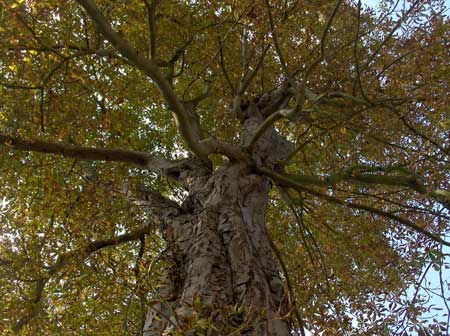 ..... .....
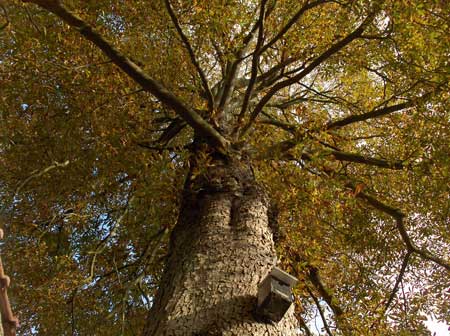 |
Autumn flowers.
 Monk's-hood
(Aconitum carmichaelii) Family Ranunculaceae, There’s also a species on the page “summer
flowers”. We had bought a coupleof these plants on the market a couple at. These
started flowering much later than the other monk’s-hood. (IX, X) Now we
have got flowers the whole year.
Monk's-hood
(Aconitum carmichaelii) Family Ranunculaceae, There’s also a species on the page “summer
flowers”. We had bought a coupleof these plants on the market a couple at. These
started flowering much later than the other monk’s-hood. (IX, X) Now we
have got flowers the whole year.
Sun-part shade.
Moist, organically rich, well-drained soils. Toxic!
|
 Cyclamen
hederifolium
In September they start flowering with
small pink flowers. Leaves appear a short time later,
then
build their size and numbers in earnest throughout November.
Heart or arrow-shaped leaves
have a pattern in silver, grey. It
self-seeds freely.
Cyclamen
hederifolium
In September they start flowering with
small pink flowers. Leaves appear a short time later,
then
build their size and numbers in earnest throughout November.
Heart or arrow-shaped leaves
have a pattern in silver, grey. It
self-seeds freely.
Native to south France to Turkey
|
 Autumn
aster (Aster
yunnanensis) I ‘m not sure it’s the right name. Height: 40 cm.. Bloom
time: IX - XI. Fertile, moist but well drained soil. Already more than
twenty years in our garden.
Autumn
aster (Aster
yunnanensis) I ‘m not sure it’s the right name. Height: 40 cm.. Bloom
time: IX - XI. Fertile, moist but well drained soil. Already more than
twenty years in our garden.
|
 Bugbane
or cohosh
(Cimicifuga simplex) Bloom time X, XI. Sun - shade
Humus rich, moist soil. Family
Ranunculaceae.
Bugbane
or cohosh
(Cimicifuga simplex) Bloom time X, XI. Sun - shade
Humus rich, moist soil. Family
Ranunculaceae.
In our garden it’s in a beautiful summer to dry. For this reason it
doesn't grow well. But I like the flowers. So they stay in the garden. Native
to the east of the United States.
|

 Ivy (Hedera helix Simone) This Ivy has been introduced in 1996 as
a new species. This shrub-like ivy does not grow higher than 90 cm. You
have got flowers at the end of the summer to late in the autumn. Black bays appear
after flowering. Especially hover flies like the flowers.
The shrub grows in the sun and in the shade and can be pruned. Evergreen.
Ivy (Hedera helix Simone) This Ivy has been introduced in 1996 as
a new species. This shrub-like ivy does not grow higher than 90 cm. You
have got flowers at the end of the summer to late in the autumn. Black bays appear
after flowering. Especially hover flies like the flowers.
The shrub grows in the sun and in the shade and can be pruned. Evergreen.
|

 False holly (Osmanthus heterophyllus 'Goshiki'). Family Oleaceae. Sun, half shade. Height 80-100 cm.
False holly (Osmanthus heterophyllus 'Goshiki'). Family Oleaceae. Sun, half shade. Height 80-100 cm.
Bloom time: Vlll-X, The small, white flowers are inconspicuous. In this photo they are in bloom after a warm autumn in November. The toothed leaves resemble those of holly. Native to Japan, Taiwan. Photos 10-3-2022 and 4-11-2022.
|

 Knotweed,
knotgrass
(Persicaria filiformis, Polygonum
virginianum)
Just at the beginning of Autumn it starts flowering. But it’s also a beautiful foliage plant.
Native
to Japan, the North east of the Himalayas and the North east of the US.
Bloom time: IX, X. Tiny red flower on a wiry stem
(difficult
to photograph) Ordinary
garden soil, grows best when not too dry. Sun-part shade. It’s self-seeding and spreads by rhizomes. But
in our garden it’s growing for 10 years at the same place (perhaps too
dry) Margriet
thanks for giving the name.
Knotweed,
knotgrass
(Persicaria filiformis, Polygonum
virginianum)
Just at the beginning of Autumn it starts flowering. But it’s also a beautiful foliage plant.
Native
to Japan, the North east of the Himalayas and the North east of the US.
Bloom time: IX, X. Tiny red flower on a wiry stem
(difficult
to photograph) Ordinary
garden soil, grows best when not too dry. Sun-part shade. It’s self-seeding and spreads by rhizomes. But
in our garden it’s growing for 10 years at the same place (perhaps too
dry) Margriet
thanks for giving the name.
|
 Knotweed,
knotgrass (Polygonum
amplexicaule) Bloom time: VII - X. So it also flowers in summer.
Family Buckwheat (Polygonaceae).
This photograph has been taken at the end of September. It prefers fertile,
moist soil. But on other soil types are not a problem. Sun - shade. It
spreads by rhizomes and by self-seeding. Knotweed can be invasive.
Knotweed,
knotgrass (Polygonum
amplexicaule) Bloom time: VII - X. So it also flowers in summer.
Family Buckwheat (Polygonaceae).
This photograph has been taken at the end of September. It prefers fertile,
moist soil. But on other soil types are not a problem. Sun - shade. It
spreads by rhizomes and by self-seeding. Knotweed can be invasive.
|
 Garden
Orpine (Sedum
teléphium) Family. Succulent leaves flushed bronze with purple stems and
clusters of soft pink flowers in late summer. Soil: moderately fertile,
well-drained. Sun-part shade.
flowering time: VII - X. I have a number of species.
Garden
Orpine (Sedum
teléphium) Family. Succulent leaves flushed bronze with purple stems and
clusters of soft pink flowers in late summer. Soil: moderately fertile,
well-drained. Sun-part shade.
flowering time: VII - X. I have a number of species.
Orphin is also a wildflower in the Netherlands.
|
 Goldenrod
(Solidago) this is Canada
golden-rod, Canada
goldenrod (Solidago
canadensis).
Family Asteraceae. Native to the United States and Canada. But now it
is often grown as a wildflower also in Europe.
The root system producing creeping rhizomes that cause the plants to
cluster, but is also self-seeding and can be invasive. Bloom time: VIII -
X. sunny. The preference is full to partial sun, and average moisture
levels, but it will tolerate also some drought. Many insects like the
flowers. I Prune the plant about 10 cm from the ground before the
new growing season begins.
Goldenrod
(Solidago) this is Canada
golden-rod, Canada
goldenrod (Solidago
canadensis).
Family Asteraceae. Native to the United States and Canada. But now it
is often grown as a wildflower also in Europe.
The root system producing creeping rhizomes that cause the plants to
cluster, but is also self-seeding and can be invasive. Bloom time: VIII -
X. sunny. The preference is full to partial sun, and average moisture
levels, but it will tolerate also some drought. Many insects like the
flowers. I Prune the plant about 10 cm from the ground before the
new growing season begins.
|

 Strobilanthes atropurpurea, Strobilanthes atropurpureu. Family Acanthaceae.
Bloomtime VII
- X.
Strobilanthes atropurpurea, Strobilanthes atropurpureu. Family Acanthaceae.
Bloomtime VII
- X.
The plant has many purple-blue flowers in late summer. I put it in the fall, because it continues to flower for a long time. It grows in any type of soil and likes warmth, but not bright sun. Sun - partial shade. Height 120 cm |
Shrubs with beautiful berries.

 Common Snowberry (Symphoricarpos
albus) flowers are already there as from June. Small spikes of pink flowers appear already in June (not
very showy, but the bees like them); fruit is white and berry-like from
September through November. At the same time there are new flowers.
Fruit remains on the stem until midwinter. The
common snowberry grows everywhere. Full sun to shade; moist, well-drained soils are best, but it tolerates
also dryness.
Reproduction also by sprouting of underground stems that run horizontally.
You can prune it well.
Common Snowberry (Symphoricarpos
albus) flowers are already there as from June. Small spikes of pink flowers appear already in June (not
very showy, but the bees like them); fruit is white and berry-like from
September through November. At the same time there are new flowers.
Fruit remains on the stem until midwinter. The
common snowberry grows everywhere. Full sun to shade; moist, well-drained soils are best, but it tolerates
also dryness.
Reproduction also by sprouting of underground stems that run horizontally.
You can prune it well.
It is native to North America. It was introduced in 1817, in Great Britain
and now it has naturalized in
Europe. The
Latin name means soap. These plants were often used as a soap by Northwest
Indians.
The fruit and flowers are photographed at the end of September.
|
 Rock
cotoneaster
(Cotoneaster horizontalis) Bloom time: V, VI. The shrubs are in the
garden and against the wall. Well drained garden soil.
Sun - shade. In the sun there are more red berries. It spreads by
self-seeding.
Rock
cotoneaster
(Cotoneaster horizontalis) Bloom time: V, VI. The shrubs are in the
garden and against the wall. Well drained garden soil.
Sun - shade. In the sun there are more red berries. It spreads by
self-seeding.
A spreading shrub to
1,5 meter tall. You can prune
it well.
Native to China
|
 Holly (Hex aquifolium) I have already described the holly on the page "spring2007
".
Holly (Hex aquifolium) I have already described the holly on the page "spring2007
". |
 English yew
(Taxus baccata) An evergreen conifer native to Europe. I had almost
forgotten the yew, although we
have a yew hedge around the back garden.
All parts of plant are poisonous and are deadly for
cattle. Its sweet fruit is completely toxin free. But you must not eat the seed. The seed is also toxic. So it’s
better to eat nothing at all. Especially the children!! Yew is used in
a cancer treatment.
The hard wood was formerly
often used for making bows. Pruning of these shrubs can be done at any time of the year.
Yew can be grown in sun or shade.
English yew
(Taxus baccata) An evergreen conifer native to Europe. I had almost
forgotten the yew, although we
have a yew hedge around the back garden.
All parts of plant are poisonous and are deadly for
cattle. Its sweet fruit is completely toxin free. But you must not eat the seed. The seed is also toxic. So it’s
better to eat nothing at all. Especially the children!! Yew is used in
a cancer treatment.
The hard wood was formerly
often used for making bows. Pruning of these shrubs can be done at any time of the year.
Yew can be grown in sun or shade.
|
Hedgehog (Erinaceus europaeus) in autumn.
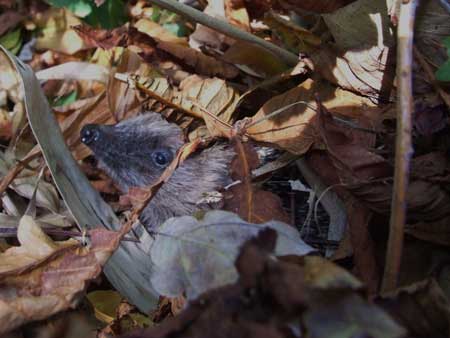 Today (20-10-09) I heard noises under a pile of leaves in the garden. When
I kept looking, I saw the head of a hedgehog.
Today (20-10-09) I heard noises under a pile of leaves in the garden. When
I kept looking, I saw the head of a hedgehog. |
Paintings in autumn. (2009)
In October there is "de Kunsttiendaagse" (translated: "ten-day art") in
Bergen (the village, where we live). In many shops, banks, hotels you can admire art for ten days.
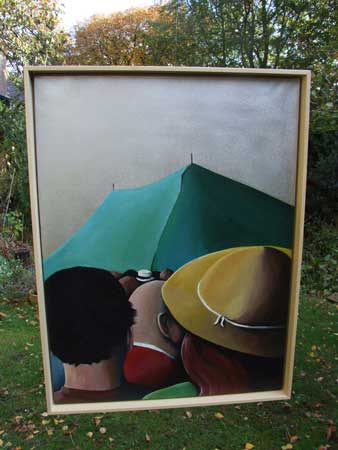 .. ..
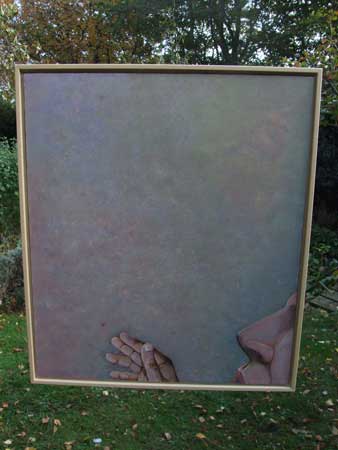 |
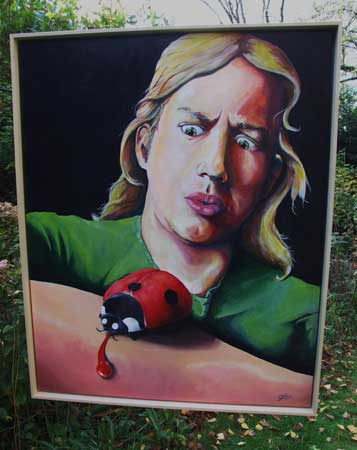 .. ..
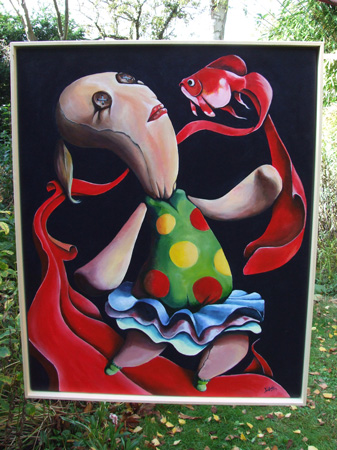 |
I have also taken some photos of two known places in Bergen.
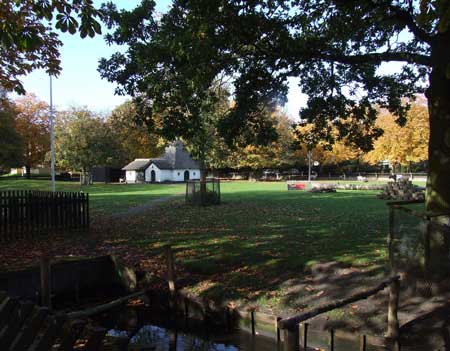 ..... .....
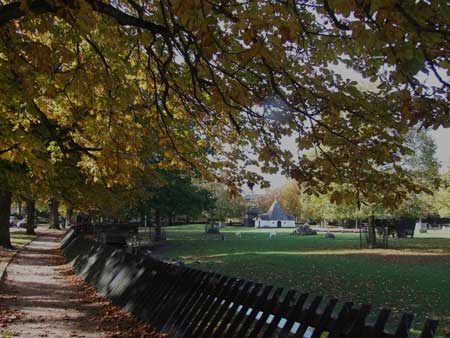 |
The Van Reenen Park.
When our children were small, we visited this park very
often.. It is near the center of the village.
Photos 25-10-2009.
The miniature golf course in Bergen. "The Merelhof"
It seems to bee the oldest miniature golf course in the Netherlands.
The license is issued by the municipality of Bergen on March 14, 1954.
This was the last weekend. From November to March, it is closed.
Also near the city center, but surrounded by nature. |
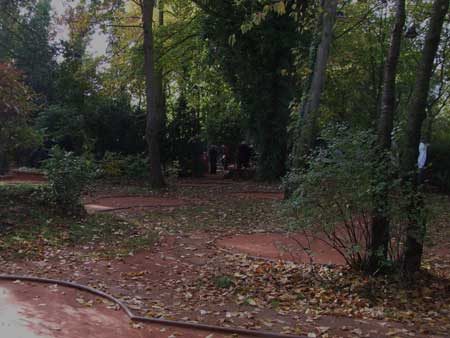 ..... .....
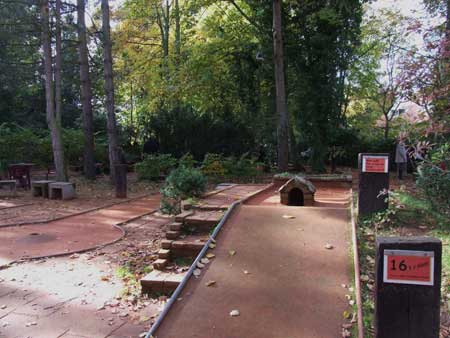 |
Het Oude Hof in Bergen. (translated: The Old Court)
There is already a year passed again. These are pictures of "de
Kunsttiendaagse" (translated: "ten-day art") in October 2010.
This time I have made some pictures of the exhibition at Het Oude Hof. I haven't
taken photos in the building of the paintings hanging there.
In the mid 17th century, this mansion was built. The estate is also without
sculptures worth a visit. Today, the building is owned by the foundation Blooming. A training company with several hotels and accommodations
for training.
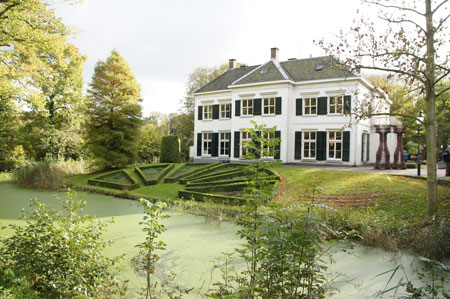 ..... .....
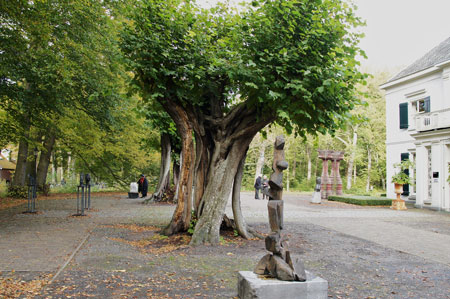 |


 . .
 The lime trees at the building were planted in 1647 by Studler of Surck. They are
also works of art, I think.
The lime trees at the building were planted in 1647 by Studler of Surck. They are
also works of art, I think. |
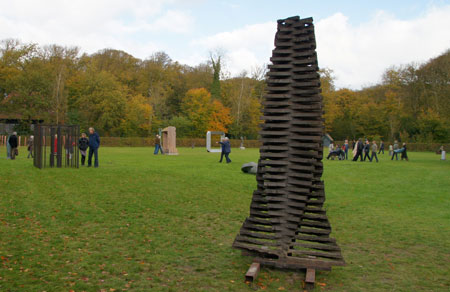 ..... .....
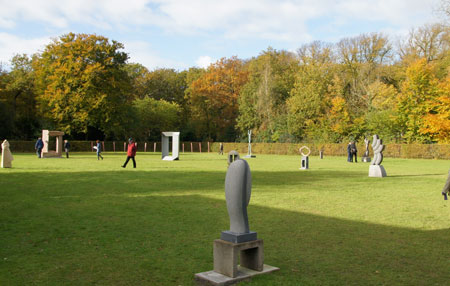 |


 . .
 Through the forest, you come to an open space. There are many modern sculptures. (During the ten-day art)
Through the forest, you come to an open space. There are many modern sculptures. (During the ten-day art) |
On these photos you see the forest, which is guarded by a pair of beautiful
"cats" and the path toward to the sculptures.
When we left, I have taken one last photo of the mansion "Het Oude
Hof". |
Robin
I also have a picture of a robin on the page "spring" and a picture on the
page "winter". Then it is not afraid of me, but it still keeps some distance. In the autumn we are good friends. If I'm raking leaves,
it is always joining me to see if there is something to eat. Sometimes I
am not glad because some insects I would like to shoot.
I hope it likes me. Often it is on a distance of about twenty centimeters. (Like in this picture)
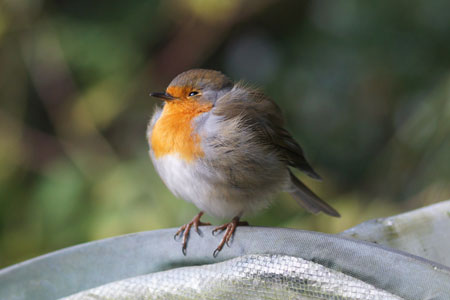 Photo 15-11-2010
Photo 15-11-2010 |
Sculptures in the fog. "De Poort van Bergen" from
Herbert Nouwens.
There is often fog in the autumn. But in November 2011 we have got
to much.
I photographed the two sculptures in the fog on the roundabout. If you go from Alkmaar to Bergen, you
can't miss them.
They are placed here in 2002. The sculptures are made of rust-colored Cor-ten steel.
The first time we saw "De Poort van Bergen", we came back from holidays. We found
them ugly. We both had the twin-towers in our mind. Like more people of
the village. In protest, cans of paint were emptied against the
sculptures. (several times) Once there even was attached a half plane to
one of the towers.
Today it has become quiet. I still think it's not nice. But we are used to
it.
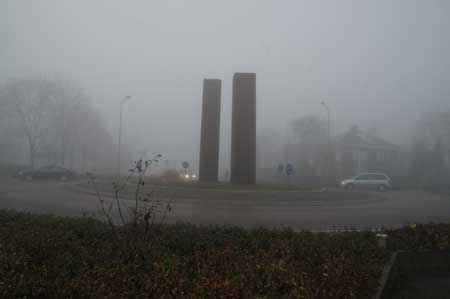 Photo 23-11-2011
Photo 23-11-2011 |
Greater White-toothed Shrew (Crocidura russula). Family Soricidae.
September 2012.
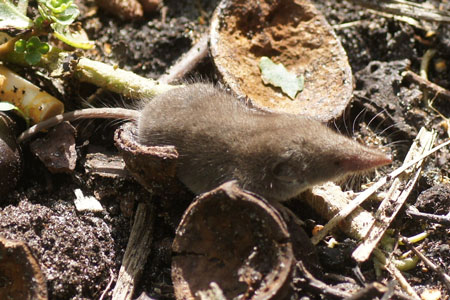 ..... .....
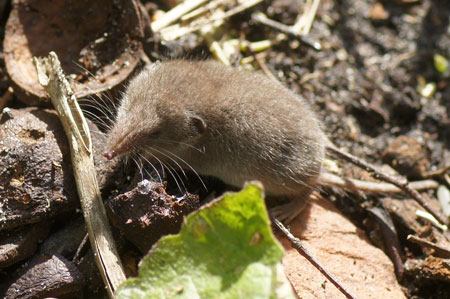 |
In a joint in the wall is an opening and so the Greater White-toothed Shrews
can come under the floor of the scullery. Only there, because it is not connected to our house.
Sometimes I see a shrew going to the the garden. Shrews are night and day searching for
food like insects, larvae, woodlice, snails, worms.
It looks like a house mouse, but is no family. There are many species of shrews.
The greater white-toothed shrew has larger ears (not hidden in the fur) and
long white hairs on the tail. I let the joint open, because it is a nice to have them in the garden. |
House mouse (Mus musculus). Family Muridae.
A picture to
compare the house mouse with the house shrew. Late autumn we sometimes have a house mouse in the house. That is not the intention. I have a trap, with which you can catch them alive. Then you
can let them free in the garden of the neighbours, but than you get
neighbours quarrel. Fortunately we have forest and dunes nearby.
They are native to Central Asia and Russia. Now they are found everywhere, where people are. They eat everything. For example, grains, seeds, insects and worms. With us they even once the putty eaten.
Once they had eaten from our glazing putty.
In the wild they can be thirty months old. But because of all the enemies, they live mostly
much shorter.
Usually you know there are mice in your house, because of the mouse droppings and gnawed broken packages.
Long-tailed Field Mouse (Apodemus sylvaticus). Family Muridae.
For the first time I saw a Long-tailed Field Mouse in the garden. I put it with the other mice, although I sawit in the summer between the plants. Characteristics: Large, upright ears, a tail longer than the body, back is golden brown and the belly white. It eats mainly seeds, but also berries, plants, beetles, snails etc.
Photos 7-7-2024.
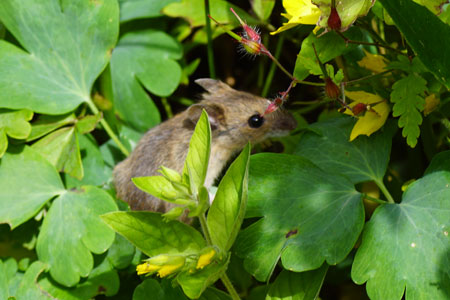 .. ..
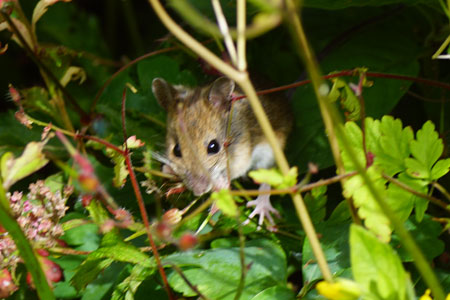
Nederlands /
Dutch
 
Subpage Summerflowers: Summer
flowering shrubs.
|
